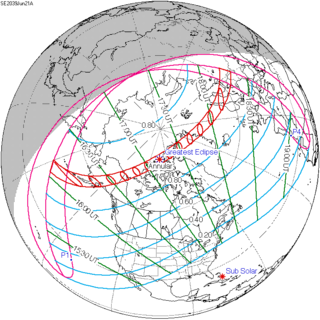Top Qs
Timeline
Chat
Perspective
Solar eclipse of June 21, 2039
Future annular solar eclipse From Wikipedia, the free encyclopedia
Remove ads
An annular solar eclipse will occur at the Moon's ascending node of orbit on Tuesday, June 21, 2039,[1] with a magnitude of 0.9454. A solar eclipse occurs when the Moon passes between Earth and the Sun, thereby totally or partly obscuring the image of the Sun for a viewer on Earth. An annular solar eclipse occurs when the Moon's apparent diameter is smaller than the Sun's, blocking most of the Sun's light and causing the Sun to look like an annulus (ring). An annular eclipse appears as a partial eclipse over a region of the Earth thousands of kilometres wide. Occurring about 2 days after apogee (on June 19, 2039, at 16:55 UTC), the Moon's apparent diameter will be smaller.[2]
Annularity will be visible from parts of Alaska, northern Canada, Greenland, Norway, Sweden, southern Finland, Estonia, Latvia, northeastern Lithuania, western Russia, and Belarus. A partial eclipse will be visible for parts of Hawaii, North America, Europe, Northwest Africa, and northern Russia.
This eclipse will start only a few hours after the northern solstice and most of the path will go across areas with midnight sun. For mainland Norway, Sweden and Belarus, it will be the first central solar eclipse since June 1954.
Remove ads
Images
Eclipse timing
Places experiencing annular eclipse
Places experiencing partial eclipse
Remove ads
Eclipse details
Summarize
Perspective
Shown below are two tables displaying details about this particular solar eclipse. The first table outlines times at which the Moon's penumbra or umbra attains the specific parameter, and the second table describes various other parameters pertaining to this eclipse.[3]
Eclipse season
This eclipse is part of an eclipse season, a period, roughly every six months, when eclipses occur. Only two (or occasionally three) eclipse seasons occur each year, and each season lasts about 35 days and repeats just short of six months (173 days) later; thus two full eclipse seasons always occur each year. Either two or three eclipses happen each eclipse season. In the sequence below, each eclipse is separated by a fortnight.
Remove ads
Related eclipses
Eclipses in 2039
- A partial lunar eclipse on June 6.
- An annular solar eclipse on June 21.
- A partial lunar eclipse on November 30.
- A total solar eclipse on December 15.
Metonic
- Preceded by: Solar eclipse of September 2, 2035
- Followed by: Solar eclipse of April 9, 2043
Tzolkinex
- Preceded by: Solar eclipse of May 9, 2032
- Followed by: Solar eclipse of August 2, 2046
Half-Saros
- Preceded by: Lunar eclipse of June 15, 2030
- Followed by: Lunar eclipse of June 26, 2048
Tritos
- Preceded by: Solar eclipse of July 22, 2028
- Followed by: Solar eclipse of May 20, 2050
Solar Saros 147
- Preceded by: Solar eclipse of June 10, 2021
- Followed by: Solar eclipse of July 1, 2057
Inex
- Preceded by: Solar eclipse of July 11, 2010
- Followed by: Solar eclipse of May 31, 2068
Triad
- Preceded by: Solar eclipse of August 20, 1952
- Followed by: Solar eclipse of April 22, 2126
Solar eclipses of 2036–2039
This eclipse is a member of a semester series. An eclipse in a semester series of solar eclipses repeats approximately every 177 days and 4 hours (a semester) at alternating nodes of the Moon's orbit.[4]
The partial solar eclipses on February 27, 2036 and August 21, 2036 occur in the previous lunar year eclipse set.
Saros 147
This eclipse is a part of Saros series 147, repeating every 18 years, 11 days, and containing 80 events. The series started with a partial solar eclipse on October 12, 1624. It contains annular eclipses from May 31, 2003 through July 31, 2706. There are no hybrid or total eclipses in this set. The series ends at member 80 as a partial eclipse on February 24, 3049. Its eclipses are tabulated in three columns; every third eclipse in the same column is one exeligmos apart, so they all cast shadows over approximately the same parts of the Earth.
The longest duration of annularity will be produced by member 38 at 9 minutes, 41 seconds on November 21, 2291. All eclipses in this series occur at the Moon’s ascending node of orbit.[5]
Metonic series
The metonic series repeats eclipses every 19 years (6939.69 days), lasting about 5 cycles. Eclipses occur in nearly the same calendar date. In addition, the octon subseries repeats 1/5 of that or every 3.8 years (1387.94 days). All eclipses in this table occur at the Moon's ascending node.
Tritos series
This eclipse is a part of a tritos cycle, repeating at alternating nodes every 135 synodic months (≈ 3986.63 days, or 11 years minus 1 month). Their appearance and longitude are irregular due to a lack of synchronization with the anomalistic month (period of perigee), but groupings of 3 tritos cycles (≈ 33 years minus 3 months) come close (≈ 434.044 anomalistic months), so eclipses are similar in these groupings.
Inex series
This eclipse is a part of the long period inex cycle, repeating at alternating nodes, every 358 synodic months (≈ 10,571.95 days, or 29 years minus 20 days). Their appearance and longitude are irregular due to a lack of synchronization with the anomalistic month (period of perigee). However, groupings of 3 inex cycles (≈ 87 years minus 2 months) comes close (≈ 1,151.02 anomalistic months), so eclipses are similar in these groupings.
Remove ads
References
External links
Wikiwand - on
Seamless Wikipedia browsing. On steroids.
Remove ads




































































































